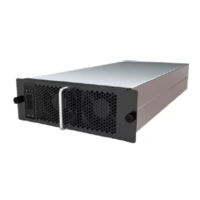Cables
● Determine the temperature resistance level of the cable insulation materials
based on the ambient temperature. Insulation materials of power cables and
communications cables must be able to resist temperatures higher than or
equal to 105°C.
● You need to prepare input connectors, output connectors, and cables by
yourself.
Table 4-1 Cable requirements
Cable Recommended Specications Remarks
DC output
power cable
Recommendation 1: ame-retardant
cable with withstand voltage ≥ 1000 V
DC, temperature resistance ≥ 105°C,
and conductor cross-sectional area of
16 mm
2
(for example: ISO 6722, 1500
V DC, 125°C, 16 mm
2
, single-core
unshielded cable)
Recommendation 2:
ame-retardant
cable with withstand voltage ≥ 1000 V
DC, temperature resistance ≥ 105°C,
and conductor cross-sectional area of
AWG 6 (for example: UL 10269, AWG
6)
Two positive cables
and two negative
cables. If the cable
surface temperature
is higher than 90°C,
use high-temperature
cables.
AC input
power cable
Recommendation 1: ame-retardant
cable with withstand voltage ≥ 600 V
AC, temperature resistance ≥ 105°C,
and conductor cross-sectional area of
10 mm
2
(for example: ISO 6722, 600 V
AC, 125°C, 10 mm
2
, single-core
unshielded cable)
Recommendation 2:
ame-retardant
cable with withstand voltage ≥ 600 V
AC, temperature resistance ≥ 105°C,
and conductor cross-sectional area of
AWG 8 (for example: UL 3386, AWG 8)
If the cable surface
temperature is higher
than 90°C, use high-
temperature cables.
R100030G1 Charging Module
User Manual 4 Installation
Issue 05 (2021-11-16) Copyright © Huawei Digital Power Technologies Co., Ltd. 23

